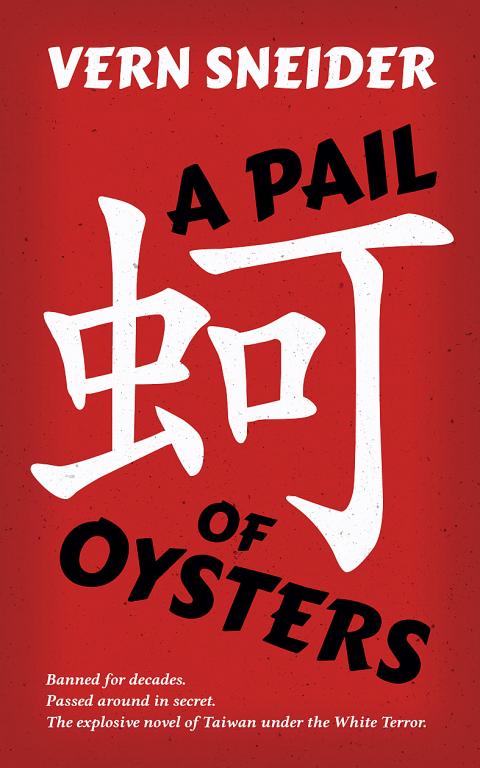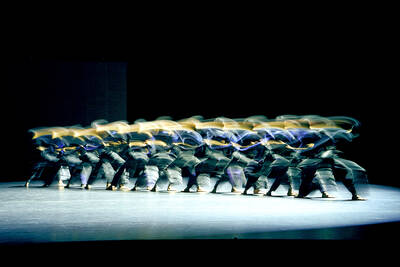Hot on the heels of the success of his debut novel, The Teahouse of the August Moon, American author Vern Sneider spent the summer of 1952 in Taiwan researching his next book.
Ushered in by the 228 Incident of 1947, the White Terror era was at its most brutal at that time as thousands of suspected political dissidents were imprisoned or executed by the ruling Chinese Nationalist Party (KMT).
The resulting book, A Pail of Oysters, was banned in Taiwan, but to Sneider’s dismay, even the US denounced it. It was the McCarthy era, and anything portraying the KMT in a negative light was inevitably painted as pro-communist. It went out of print shortly after.

Photo courtesy of camphor press
While Mandarin and Hoklo (commonly known as Taiwanese) translations have been available since 2003, English editions are rare (rumor has it that pro-KMT students hunted down and destroyed copies from US libraries), with Abebooks.com just listing six copies, ranging from about NT$900 to NT$3,800.
“It’s one of those books that were passed around in secret during the bad old days,” Taiwan and UK-based Camphor Press cofounder Mark Swofford says.
Camphor Press is today releasing the first republishing of the book since the 1950s in digital format, with a print edition to come soon.
“It was suppressed and never got a fair hearing. We want to give it one,” Swofford says.
The book depicts life during White Terror through a variety of characters — most prominently Li Liu, a half-Hakka and half-Aborigine whose family is robbed by KMT soldiers at the beginning of the novel.
But bashing the KMT isn’t the point of the novel, Swofford says.
“It’s a very complex novel, [written] when many people thought it was just the communists versus the KMT,” he says. “It was more of a middle way sort of thing; from the standpoint of the Taiwanese people.”
RE-INTRODUCTION
Late last year, Jonathan Benda, a lecturer at Boston’s Northeastern University, found himself interviewing Sneider’s 85-year-old widow, June.
Benda was familiar with A Pail of Oysters. He read it during his 18-year stay in Taiwan and published an academic paper on it in 2007. Benda says he had once considered republishing it, but lacked the means to do so — and was surprised when Camphor Press asked him to write the introduction to their new edition.
Benda was eager to learn more about the book. In addition to speaking to June, he also dug up old articles and correspondences and obtained copies of the author’s notes through his hometown museum in Monroe, Michigan.
Stationed in Okinawa and Korea, Sneider had never been to Taiwan before the summer of 1952, but the US Army had him study the country at Princeton University in preparation for possible military occupation during the war.
Benda was impressed with the amount of research Sneider’s notes contained — including interviews with people ranging from then-governor K.C. Wu (吳國楨) to pedicab operators and extensive notes on items such as how children are named and blind masseuses. He even had his palm read, which is featured in the novel.
“It’s easy to point out mistakes or problems with his depictions … but I come away thinking that he got a lot of it right,” Benda says.
Through examining letters, Benda found that Sneider had hoped to counter the pervading pro-KMT perception of Taiwan as “Free China” and show how its people were actually suffering under martial law.
“My viewpoint will be strictly that of the Formosan people, trying to exist under that government,” he wrote to George H. Kerr, author of Formosa Betrayed. “And … maybe, in my small way, I can do something for the people of Formosa.”
But although Sneider was critical of the government, he generally gives a balanced picture, including democracy proponents in the KMT and sympathetic soldiers, Benda says.
In addition, the American perspective is shown through the eyes of Ralph Barton, a journalist investigating life in Taiwan under martial law — which corresponds to Sneider’s role, except that the author believed that fiction is a more powerful vehicle through its “emotional pull,” as detailed in his letter to Kerr.
Sneider died in 1981 — too early for any chance to redeem his book, but at least June is able to see it happen.
“She was glad to have this out during her lifetime,” Swofford says.

Most heroes are remembered for the battles they fought. Taiwan’s Black Bat Squadron is remembered for flying into Chinese airspace 838 times between 1953 and 1967, and for the 148 men whose sacrifice bought the intelligence that kept Taiwan secure. Two-thirds of the squadron died carrying out missions most people wouldn’t learn about for another 40 years. The squadron lost 15 aircraft and 148 crew members over those 14 years, making it the deadliest unit in Taiwan’s military history by casualty rate. They flew at night, often at low altitudes, straight into some of the most heavily defended airspace in Asia.

Taiwan’s democracy is at risk. Be very alarmed. This is not a drill. The current constitutional crisis progressed slowly, then suddenly. Political tensions, partisan hostility and emotions are all running high right when cool heads and calm negotiation are most needed. Oxford defines brinkmanship as: “The art or practice of pursuing a dangerous policy to the limits of safety before stopping, especially in politics.” It says the term comes from a quote from a 1956 Cold War interview with then-American Secretary of State John Foster Dulles, when he said: ‘The ability to get to the verge without getting into the war is

Beijing’s ironic, abusive tantrums aimed at Japan since Japanese Prime Minister Sanae Takaichi publicly stated that a Taiwan contingency would be an existential crisis for Japan, have revealed for all the world to see that the People’s Republic of China (PRC) lusts after Okinawa. We all owe Takaichi a debt of thanks for getting the PRC to make that public. The PRC and its netizens, taking their cue from the Chinese Communist Party (CCP), are presenting Okinawa by mirroring the claims about Taiwan. Official PRC propaganda organs began to wax lyrical about Okinawa’s “unsettled status” beginning last month. A Global

Like much in the world today, theater has experienced major disruptions over the six years since COVID-19. The pandemic, the war in Ukraine and social media have created a new normal of geopolitical and information uncertainty, and the performing arts are not immune to these effects. “Ten years ago people wanted to come to the theater to engage with important issues, but now the Internet allows them to engage with those issues powerfully and immediately,” said Faith Tan, programming director of the Esplanade in Singapore, speaking last week in Japan. “One reaction to unpredictability has been a renewed emphasis on